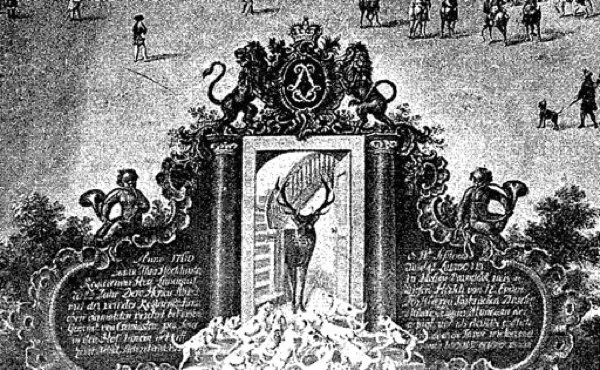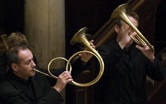HIP hip
October 2009

Return of the Corno da Tirarsi
Olivier Picon, who played with us last March, has made some small alterations to the prototype of the corno da tirarsi, as kindly supplied by Blechblasinstrumentenbau Egger, that you may have heard here last October. Olivier has been busy performing and recording on the Corno da Tirarsi, and is scheduled to return to the Swaen stage next April. In the next couple of months, his detailed write-up on the research into this organological conundrum will be available on the De Swaen website where you can also read about our choice of instruments and other decisions in Historically Informed Performance (HIP).
On the subject of horns, some of our regular listeners have commented on the “different” way horns are played in De Swaen, (although last Sunday, you may have seen the Madeuf brothers playing in a similar way at the Concertgebouw).
There are many aspects of 19th century Romantic traditions that still affect HIP - from turgid tempi to “interpretative” conductors. During the 18th century, massive changes in social structure saw the beginning of the Industrial Revolution and the decline of a feudal system ruled by powerful courts. As the courts disappeared, so did their orchestras and other trappings of grandeur, such as bands of highly-skilled trumpeters and lavish hunts.
As a result of these changes, by the end of the 18th century, the art of clarino (high trumpet) and “high” horn playing, so familiar to Baroque composers, had been lost and the instruments’ symbolism suppressed. The horn survived - albeit muffled with a hand in its bell- but it was to be another 150 years or so before the trumpet was taken seriously again as a solo “art-music” instrument.
Before then, trumpeters, being also essential for military signalling, had been exclusively selected, highly valued, well paid and protected by a guild, since they directly represented nobility. (Specialised brass-playing Stadtpfeiffers were also very privileged.) Trumpeters would also have played horns at a noble’s most-envied status symbol, the hunt. The horn, since its sound was similar to the baying of hounds, was often featured in the music written for hunting celebrations and this character was used symbolically in other works.
To stick a hand or drill holes into instruments that had defined purity, the Divine, Royalty and nobility for centuries, would have been an act of unthinkable sacrilege.
Hopefully this explains why we feel it important to recapture the spirit of unsuppressed, pre-Romantic Droit du Seigneur with the triumphant sound of horns played in the original way, come what may.
Mike Diprose
October 2009


Thanks to Graham Nicholson for building the horns in G.
Nederlandse samenvatting
Olivier Picon, die vorig seizoen in Maart samen met Jean François Madeuf Bachs eerste Brandenburgs Concert met ons uitvoerde –en die in April 2010 weer met ons zal spelen- heeft wat kleine dingen veranderd aan het prototype van de corno da tirarsi (met dank aan Blechblasinstrumentenbau Egger van wie we het
instrument mogen lenen). De Corno da Tirarsi beleefde vorig jaar Oktober -bij De Swaen- zijn vuurdoop en klinkt nu weer in cantate BWV 89. In de komende maanden zullen we Olivier Picon’s uitgebreide studie naar dit musicologisch raadsel publiceren op onze website, waar u nog veel meer kunt lezen.
Wat betreft hoorns: een aantal luisteraars heeft opgemerkt dat de hoorns in De Swaen “anders” bespeeld worden (hoewel u wellicht afgelopen zondag de gebroeders Madeuf in het concertgebouw op dezelfde manier heeft zien spelen).
HIP (Historically Informed Performance) wordt nog steeds in grote mate beïnvloed door 19e eeuwse romantische tradities. In de loop van de 18e eeuw, leidden gigantische sociale veranderingen tot het begin van de industriële revolutie en de teloorgang van het feodale systeem. Met de adelijke hoven verdwenen ook hun orkesten en andere tradities uit de hofhouding, zoals ensembles van zeer bekwame trompettisten en weelderige jachtpartijen.
Als gevolg van deze veranderingen was de kunst van het clarino- (hoge trompet) en hoge-hoorn-spel, zo veel gebruikt door barok-componisten, aan het eind van de 18e eeuw totaal uitgestorven en werd de symboliek van de instrumenten onderdrukt. De hoorn overleefde –ofschoon mompelend met een hand in de beker- maar het duurde ruim 150 jaar eer de trompet weer als serieus solo-instrument werd gezien.
Vóór die tijd werden trompettisten –die ook onmisbaar waren in het leger, uitverkoren, hoog gewaardeerd, goed betaald en beschermd door een gilde, omdat ze de adel representeerden. (De koperblazers onder de Stadtpfeiffers hadden ook speciale rechten.) Trompettisten speelden hoorn tijdens het meest begeerde status-symbool van een edelman, de jacht. Omdat de klank van de hoorn te vergelijken is met het huilen van honden werd het instrument vaak gebruikt in muziek voor jacht-ceremonies en symboliseren hoorns het jacht-karakter in andere stukken.
Het zou ondenkbare heiligschennis zijn om een hand te steken of gaten te boren in instrumenten die eeuwenlang reinheid, het Goddelijke, Koninklijkheid en Adel hadden gesymboliseerd.
Hopelijk verklaart dit waarom wij het belangrijk vinden om de geest van het ononderdrukte, pre-Romantische Droit du Seigneur te heroveren, met de triomfantelijke klank van hoorns in hun originele vorm.
Veel dank aan Graham Nicholson voor het bouwen van de hoorns in G.
|



